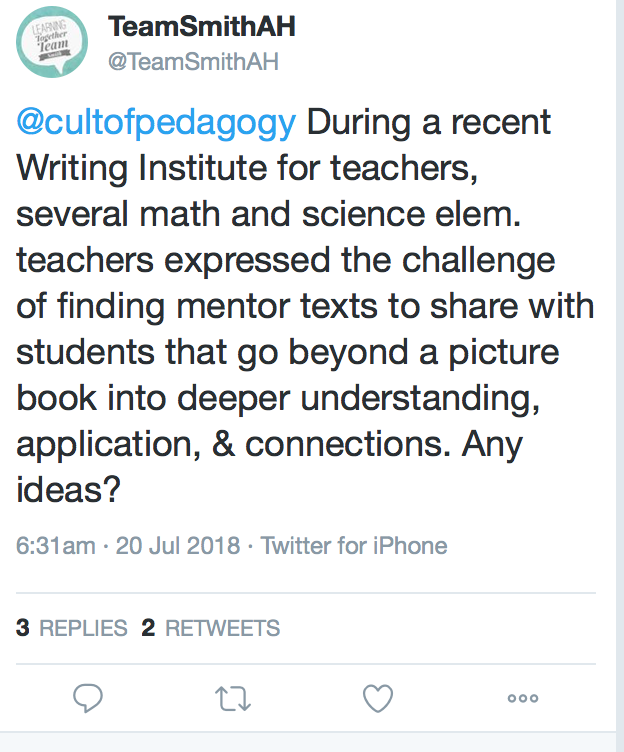Thank you @TeamSmithAH and @cultofpedagogy for tweeting this out on Sunday. I love when a tweet gets me thinking and inspires a blog post.
Here was the first tweet that a friend tagged me....
Since I like to be clear before making book recommendations, I asked for some clarification about what was specifically being requested. Here was the reply...
Though I never did find out what was meant by "classic math picture books", I began to think more about this and it sparked several thoughts.
Mentor Texts vs. Idea Books
First let me define mentor texts for the purpose of this post. Mentor texts are books or a passage that demonstrates a writing technique or craft move that students can study and incorporate it into their own writing.
If I am writing a math or science paper or book, I might pull a variety of books where authors have done similar work and study their technique. Writing for math or science will often look and sound different than a narrative fiction text.
As I have kept reading, I discovered nonfiction that is written in engaging and descriptive styles...
and ones that helped students understand how to compare and contrast...
and others that explored the ideas through a question and answer format...
and others that teach about cause and effect...
There are so many rich and wonderful nonfiction books out there that can be used as a mentor text for learning about author's craft moves and to also inspire students to ask questions and to seek more information.
Need for More Math and Science Picture Books
Do we have enough? Can we use more book? Yes, there are not enough books out there to cover the various concepts that teachers expressed interest in. There tends to be an abundance of books in specific areas such as biographies, animal books, and outer space. However, there are many more concepts to write about to meet the needs expressed by teachers.
A Classic Math Picture Book Transformed
I am particularly curious about the phrase "classic math picture books". My interpretation of the phrase should not be seen as what was being communicated by the individuals who tweeted the original tweet. However, I want to share how I would define "classic math picture book".
Eight years ago, I was that educator who was not familiar with the new and improved children's nonfiction. I would have assumed that most children's math books were books that essentially were counting books for preschoolers.
And the science books were dry and boring and a chore to read. And then I started reading and discovered that there is a whole new world of books out there.
I remember reading Blockhead: The Life of Fibonacci by Joseph D'Agnese and John O'Brien and being inspired to do a lesson with 4th graders on the Fibonacci Sequence.
Or being inspired by Edgar Allen Poe's Pie: Math Puzzlers in Classic Poems by J. Patrick Lewis.
Or being fascinated by the research and ways that LeUyen Pham included math in her artwork of The Boy Who Loved Math: The Improbable Life of Paul Erdos by Deborah Heiligman and Illustrated by LeUyen Pham.
Or amazed by A Hundred Billion Trillion Stars by Seth Fishman and Isabel Greenberg and thinking about how children would react to the way the concepts were communicated.
It is true that these books don't include lesson ideas but they are inspiring and with a little work lessons can be developed. However, don't underestimate how these books will inspire students to be creative and ask questions and be curious about concepts.
Resources to check out:
If you are looking for lesson ideas, here are two books that are exceptional.
Craft Moves: Lesson Sets for Teaching Writing with Mentor Texts by Stacey Shubitz (Stenhouse, 2016)
Perfect Pairs: Using Fiction and Nonfiction Picture Books to Teach Life Science 3-5 by Melissa Stewart and Nancy Chesley (Stenhouse Publishers, 2016)
Don't forget to link up your nonfiction reviews...














